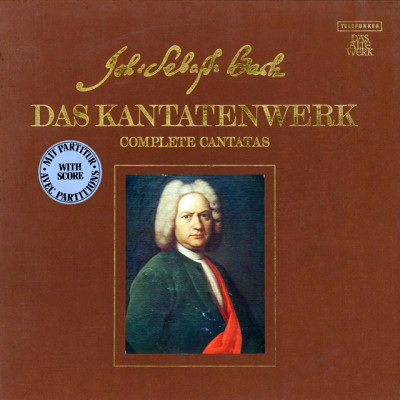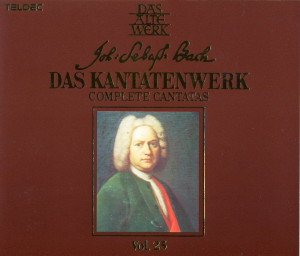 |
|
2 LPs
- 6.35443 EX - (p) 1980
|
 |
| 2 CDs -
8.35443 ZL - (c) 1989 |
|
| DAS KANTATENWERK - Volume 25 |
|
|
|
|
|
|
|
| Johann Sebastian
BACH (1685-1750) |
Kantate
"Was Gott tut, das ist wohlgetan"
III, BWV 100
|
|
23' 42" |
|
|
Ohne
Bestimmung
|
|
|
|
|
Text:
Samuel Rodigast 1674
|
|
|
|
|
Solo:
Sopran, Alt, Tenor, Baß - Chor; Horn I,
II, Pauken; Querflöte, Oboe d'amore;
Streicher; B.c. (Violoncello, Violone,
Organo)
|
|
|
|
|
- 1.
Chor: "Was Gott tut, das ist wohlgetan"
|
4' 47" |
|
B1 |
|
- 2.
Aria -Duetto (Alto, Tenore): "Was Gott
tut, das ist wohlgetan" |
3' 57" |
|
B2 |
|
- 3.
Aria (Soprano): "Was Gott tut, das ist
wohlgetan" |
4' 41" |
|
B3 |
|
- 4.
Aria (Basso): "Was Gott tut, das ist
wohlgetan" |
4' 18" |
|
B4 |
|
- 5.
Aria (Alto): "Was Gott tut, das ist
wohlgetan" |
3' 48" |
|
B5 |
|
- 6.
Chor: "Was Gott tut, das ist wohlgetan" |
1' 59" |
|
B6 |
|
|
|
|
|
|
|
|
|
|
Detlef
Bratschke (Solist des Knabenchores
Hannover), Sopran
Paul Esswood, Alt
Kurt Equiluz, Tenor
Max van Egmond, Baß
Knabenchor Hannover |
Heinz Hennig, Leitung
Collegium Vocale Gent | Philippe
Herreweghe, Leitung
Das verstärkte LEONHARDT-CONSORT mit
Originalinstrumenten
- Ab Koster, Jos Konings, Hörner
- Nick Woud, Pauken
- Frans Brüggen, Flauto traverso
- Bruce Haynes, Oboe d'amore
- Marie Leonhardt, Janneke van der Meer,
Ruth Hesseling, Antoinette van den Hombergh,
Keiko Watanabe, Violinen
- Wiel Peeters, Violen
- Anner Bylsma, Wouter Möller, Lidewij
Schijfes (BWV 100,4), Violoncelli
- Anthony Woodrow, Violone
- Gustav Leonhardt, Bob van Asperen (BWV
100,4), Orgel
Gustav Leonhardt, Gesamtleitung
|
|
|
|
|
Luogo
e data di registrazione |
|
Doopsgezinde Kerk,
Haarlem (Holland) - Settembre 1978
|
|
|
Registrazione: live
/ studio |
|
studio |
|
|
Producer |
|
Wolf Erichson
|
|
|
Prima Edizione LP |
|
Telefunken "Das Alte
Werk" | 6.35443 EX | 2 LPs -
durata 42' 15" - 45' 35" | (p)
1980 | ANA
|
|
|
Edizione CD |
|
Teldec Classics |
LC 6706 | 8.35443 ZL | 2 CDs -
durata 42' 15" - 45' 35" | (c)
1989 | ADD |
|
|
Cover
|
|
Johann Sebastian
Nach, einige Jahre vor seiner
Ernennung zum Kantor in Leipzig.
Gemälde con JJ. Ihle (1720) Bach
Museum Eisenach.
|
|
|
Note |
|
In questo volume sono
presenti anche La Cantate BWV 99,
BWV 101 e BWV 102 a cura del
Concentus Musicus Wien diretto da
Nikolaus Harnoncourt.
|
|
|
|
|
INTRODUCTION
by Ludwig Finscher
BWV 98 and 99 were followed
by a third work on Samuel
Rodigast’s hymn »Was
Gott tut,
das ist wohlgetan«: BWV
100, written some time
between 1732 and 1735 and
thus one of the last of
Bach’s surviving cantatas.
It was not allocated to a
specific Sunday; since the
text is retained unaltered
throughout the six stanzas,
the work can be used on all
manner of occasions
throughout the
ecclesiastical year. The
text is much more unified
than in BWV 99 and the
musical form is
correspondingly simpler and
even more obviously
symmetrical: the first and
sixth stanzas are
large-scale chorale settings
with concertante orchestra;
stanzas 2 to 5 are a duet
for Alto and Tenor and three
arias, for Soprano, Bass and
Alto; the key structure is G
major - D major - B minor -
G major - E minor - G major.
As though to compensate for
this simplicity, there is a
wealth of diversity in
detail, particularly in the
solo movements. The first
and last choruses are
borrowed from older cantatas
- the opening stanza is the
same as that of BWV 99, the
sixth is the final chorus of
BWV 75, though both are even
more joyful and resplendent
than the original versions,
owing to the addition of two
horns and timpani. As in BWV
99, the duet vividly calls
to mind the Italian chamber
duet (Steffani, Handel) on
account of the motet-style
arrangement of the text and
the imitatory interweaving
of the vocal parts; however,
a quasi-ostinato of eight
bars played by the continuo
not only strengthens the
strict adherence to this
tradition, but also
emphasises the deliberate
symbolism by matching the
rule of law in the music to
that in the words. On the
other hand, the three arias,
with their sensitive writing
and suggestion of the
Siciliano, display Bach at
his most modern: the Soprano
aria has a most taxing flute
part, the oboe d’amore is
given a dulcet, affective
solo to play in the Alto
aria, and ingratiating
parallel thirds and sixths
played by the violins
introduce an element of the
galant into the Bass aria.
These pieces provide
evidence as beautiful as it
is eloquent of the fact, all
too often overlooked, that
Bach was by no means a
conservative composer.
|
  |
|
|